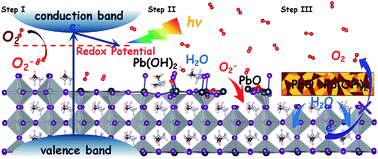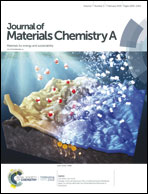Photo-oxidative degradation of methylammonium lead iodide perovskite: mechanism and protection†
Abstract
Although the power conversion efficiency of perovskite solar cells has exceeded 23%, the poor ambient stability of organic–inorganic halide perovskites poses a challenge for their commercialization. Comprehensive understanding of the underlying degradation mechanisms is a crucial step to seek approaches that can effectively suppress the degradation of perovskites. Herein, on the basis of extensive first-principles calculations, a three-step photo-oxidative degradation mechanism of MAPbI3 at the atomic level is revealed. We find that, in a dry ambient environment, the photo-generated superoxide anions (O2−) first lead to fast surface oxidation. However, further oxidation of the perovskite interior is hindered by the solid oxidation product. The fresh water produced in surface oxidation leads to the hydration of the inner perovskite and eventual breakage of the MAPbI3 lattice. We devise a practical strategy for protecting MAPbI3 from photo-induced decomposition by anchoring hydrophobic 2-(4-fluorophenyl)propan-2-amine on the surface of MAPbI3. The surface modification significantly retards the photo-induced decomposition.

- This article is part of the themed collection: International Year of the Periodic Table : From Pb and Sn Perovskites to the Next Generation


 Please wait while we load your content...
Please wait while we load your content...